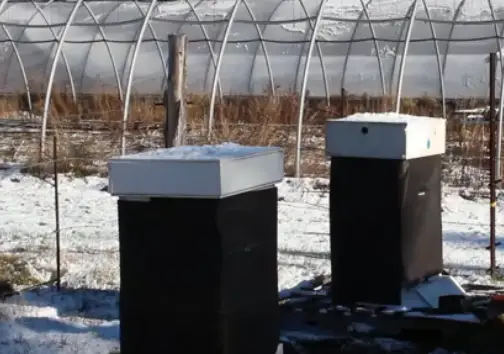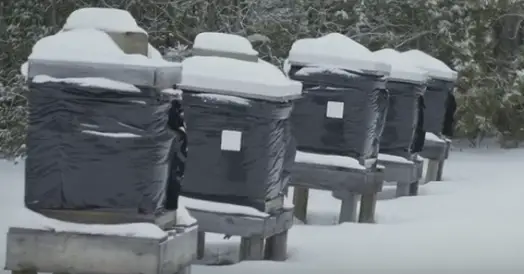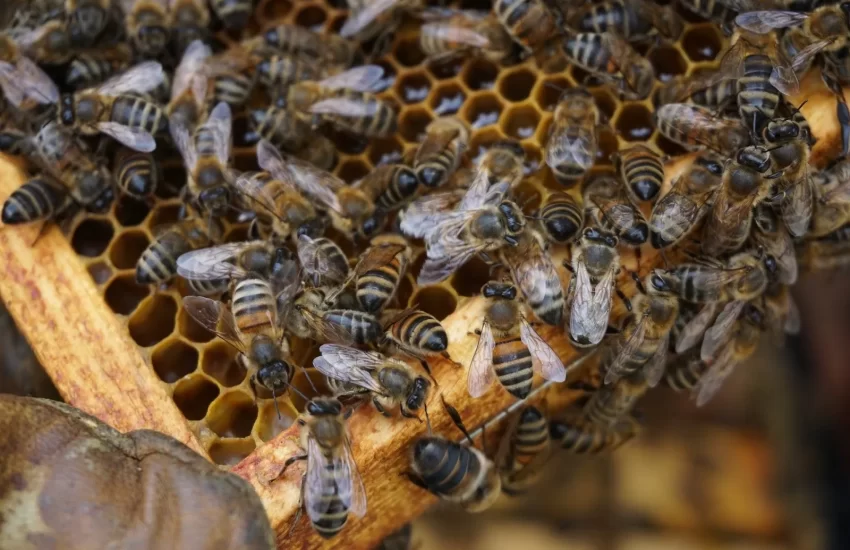How to wrap a beehive for cold winters
The winter season is always a tough time for our buzzing friends. Fortunately, the bees are exceptional planners, and they prepare for the season by keeping honey reserves. The more severe the winter climate, the more stress is placed on the colonies.
You should always work to reduce stress on your bees to have healthy colonies in spring. It is also likely to lose colonies in winter, which is an expensive loss.
Similar Articles you may like to read –
How to feed bees in summer and winters
How much honey should I leave for winter?
How do you keep moisture out of a beehive in the winter?
How do you winterize a beehive?
Can a bee nuc survive the winter?
What Happens in the Beehive During Winter
Workers cease to forage with temperatures below 12 degrees centigrade and the brood-rearing ends. The drones, whose primary role is to mate with the queen, are evicted from the hive to reduce the pressure on the stored food reserves. Although the bees lack activity, they do not hibernate.
They form a winter cluster in the middle of the two hive bodies, with the queen at the center. She is kept warm by being surrounded by thousands of bees. The colder the temperature, the tighter the bee cluster. Maintaining the warmth requires lots of energy hence the need for abundant food resources.
The bees generate heat by shivering their wing muscles. They maintain a temperature of 96 degrees F at the center of the cluster. Those near the queen rotate with those on the outer side, so no one gets worn out. They only break the cluster when the temperature is warm enough. The cluster moves around the hive consuming the honey reserves.
If it gets cold in the hive, the bees cannot move, and even with plenty of food resources in the hive, they won’t survive. While they generate heat in the hive, they release vapor causing condensation in the hive. This wetness can kill your colony just as freezing from winter.
Wrapping or Not Wrapping Your Colony
Wrapping helps to seal out harsh winter winds. It also increases the survival rate of the colony.
On the other hand, it is very dangerous if done incorrectly. It causes moisture build-up in the hive, freezing and killing your colony. A strong colony with enough stores and a decently constructed home can survive most of the winters without added protection.
How to Wrap a Beehive for Cold Winters

A Wrapped hive has black roofing around it. It is necessary for a cold area ( below 20 degrees centigrade). Your climate determines the cover you use. It is advisable to check other beekeepers in you area to see what they use.
Examples of winter wraps include tar paper, corrugated plastic wraps, foam boards, and insulating blankets. On a sunny day, a wrapped hive takes advantage of solar gain on sunny days. This raises inside the hive a few degrees which may help the cluster to move closer to food resources.
Step By Step Process Of Wrapping a Beehive
- The first step is to evaluate the colony’s wintering ability. The colony should be in 3 deep hive bodies and the holes in the bottom boxes should be closed.
- Open the hole in the top box. If it is missing, you should drill one.
- Place a moisture board on top of the inner cover. This porous sheet will help to absorb moisture and evaporate it to the outside.
- Now place the beehive winter wrap of your choice over the colony. Its height should match the number of boxes you have between the bottom board and telescoping cover. Use a staple gun to fix the wrap on the hive.
- Cut a hole on the winter wrap to correspond with the top entrance hole.
- Put the top cover.
- Place a rock on top of the cover to prevent the wind from blowing it off and the colony. Now your colony is ready for winter.
Checking the Wintering Ability of Your Colony
Here are the things to examine:
Food Supply
Ensure there are adequate honey reserves for the colony. You will require two deep bodies or three mediums full of honey( approximately 70 lbs). Supplemental feeding helps bees that had not prepared for winter adequately. You need to add some sugar if the honey stores are not sufficient. It is a better option than leaving your colony to starve and die.
Bee population
You will need a decent bee population to survive the winter( 8-10 frames of bees). You can combine weak hives to make a more vigorous population. You can also combine a weak colony with a strong colony and ensure enough food reserves for both.
Queen
You need a healthy, vigorous queen to survive the winter and to start laying eggs towards the end of the season to have a new bee population coming up in spring. Some don’t make it through the winter and need to be replaced.
The health of the Colony
The bees should be disease and pest-free to survive through the winter. They should be treated for parasites and diseases in falls.
Position of the Hive
You should face the hive entrance towards the sun so that the hive can get warm on warmer days.
Ventilation
Ventilation is a critical issue in winterizing the hives. Drill a small hole at the top of the inner cover to release moist air. It allows airflow. There is a thin line for beekeepers: when there is too much ventilation, the bees can’t keep the hive warm. When too little causes condensation to build up. The best option is to drill a one–inch hole in the top corner of the upper brood.
Space in the Beehive
You should remove unnecessary space from the hive. Overwintering your bees in a small space will prevent heat diffusion and keep the bees from using excessive energy to warm their cluster. Remove the empty boxes( top bars). It will also limit the space available for mice and other critters looking for a warm area. You should also remove the queen excluder. If it is left in the hive, the queen will be left behind as the cluster moves up. This will queen your queen bee.
Location of Honey
Ensure the honey is in the correct location. In a Langstroth hive, the frames of honey should be on top of the cluster and on either side of the cluster. The bees usually organize their food stores well, but sometimes they may need some adjustments. The cluster should be able to move in one direction as they eat the food reserves.
Windbreaks
You should set up a permanent windbreak to protect the apiary from the strong winter winds. Great permanent options include fencing or planting evergreens. The windbreaks should be taller than the hives to help direct the strong winds up and over. Again they should not be close to the beehives to not interfere with airflow( 5 feet).
Securing the Hives
Strong winds can dismantle the hive. It is good to place a heavyweight on top of the hive-like stones, bricks, or a cinder block. You can also use the ratchet straps to tie down the covers tightly.
Limit Hive Inspections
You should generally stay out of the hive in the winter season. However, you can take a peek inside when the days are warm. You can check whether there is a need for supplemental feeding or if there is activity inside. You also need to check the entrances to clear off dead bees to allow bees to exit for cleansing flights in fair weather.
Mice Guards
Ensure there are mice guards or poison to keep the nice from inhabiting the hive.
Types of Beehive Wraps for Winter
Hay Bales
The bales can be stacked around the three sides of the hive, leaving the entry side bare.
Tar Paper
Tar paper is a cheap and standard sealant used in construction. Its black color helps absorb the sun’s heat and raises the hives’ temperature inside the hive a few degrees. You can use a staple gun to fix the paper on the hive and cut off the paper from ventilation holes at the top and the bottom with a utility knife.
EZ- on Hive Wrap
This is a pre-made wrap of vinyl-coated polyester with insulating foam secured with Velcro. It is one of the easiest wraps to use.
Polystyrene Hive Component
These are boxes with in-built plastic frames. The metal latches and frames hold the insulated components, protecting against extreme weather.
Styrofoam Board
It helps retain heat within the hive rather than absorbing it from the outside.
A Bee Cozy
These are fiberglass-filled plastic-covered sleeves that fit perfectly over the hive box. They are breathable and waterproof. They help to keep humidity levels moderate and temperatures stable.
Disadvantages of Wrapping the Hive in Winter
- The wrapping may warm the colony too much, such that the bees begin to take cleaning flights while the temperatures are not warm enough on the outside.
- Excess moisture may accumulate in the hive causing the bees to freeze to death.
Does Wrapping Help to Insulate the Colony
Unlike wrapping, insulation slows down heat transfer. A beekeeper adds some material around the hive, such as a foam board, to help keep the heat generated by the hive cluster. The bees maintain the cluster’s center at 96 degrees F while the edges are around 41 degrees. Below this temperature, the bees are unable to move.
Insulation Techniques
The need for extra insulation depends on the location. If you are a new beekeeper it is good to consult beekeepers from your locality. Here are some of the general techniques.
Ensure the nest is watertight
Check the roof and box sides for cracks and holes that might allow extreme cold air or moisture to get into the hive. Seal them perfectly. Screened bottom boards should be replaced with solid boards.
Use insulation boxes
This is a shallow box stacked with dry organic material. It helps maintain the colony’s heat and draw out excess moisture.
Moisture Control in the Hive During Winter
While bees vibrate to keep warm, they release some vapor that condenses at the top of the hive. This water can drip down and wet the bees. This is shown to avoid moisture build up:
- Tilt the hive forward slightly so that the condensation can drain from the hive instead of dripping.
- Provide an upper entrance. It gives the bees a closer alternative that they can use if the lower opening is blocked. It also helps to vent out moisture.
- Add an insulating material( dead air space) such as wood shavings, porous pads, fiber grass, or burlap between the outer and inner cover to help retain the heat as well as absorb moisture. You can also use moisture control boards that are available on the market.
What Can Make the Hives Fail in Winter
- Long, cold winters
- Death of the queen bee
- Insufficient food
When to Move Your Colony in
If you are in a harsh climate, you can consider moving your colony into a garage or shed. If you decide to move this way, move them after the foraging season is over so that they don’t get stuck in their original home. On warm days be sure to move them out in the open with an open entrance to take cleaning flights.
More articles you may like to read –
Where should I put my beehive in my yard?
How close to a fence can you put a beehive?
Which direction should beehives face?
Which is better, 8 frame or 10 frame beehive?
FAQs
What quantity of honey does a bee colony require in winter?
It depends on the size of the colony and the length of the winter. A typical range is between 50 – and 100 pounds.
Is it right to feed your colony with sugar water during winter?
Sugar water is not a good idea for your bees in winter. The bees will need to work extra hard to metabolize the sugar into a honey-like substance. You can use fondant, candy boards, or sugar bricks instead.
Should I close the screened bottom board in winter?
It is good to replace the screened bottom board with solid bottom boards if you are in a region with harsh winters.
Is there a risk in wrapping my beehive in winter?
Wrapping your hive without proper ventilation will lead to condensation problems.
Is wrapping a bee colony in winter necessary?
It is only necessary if you live in a colder climate.
When is the best time to wrap your hive?
There is no specific date for wrapping your colony. You need to know what is happening in the hive and how the weather is doing. When you realize that it is getting cold and staying that way, it is an ideal time to wrap your pack.



